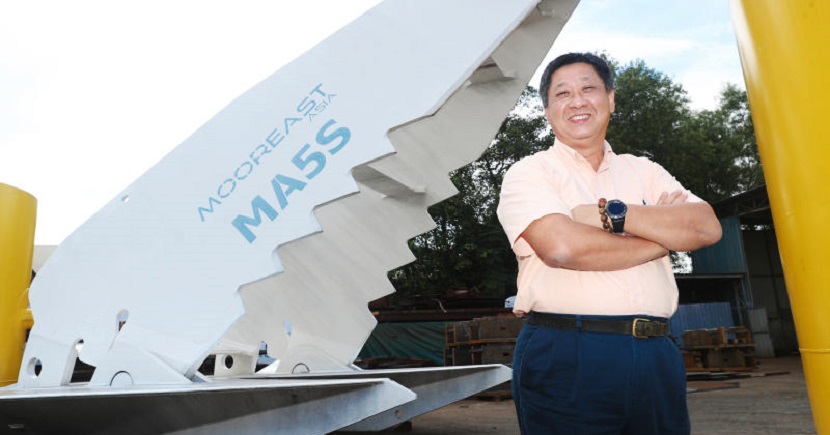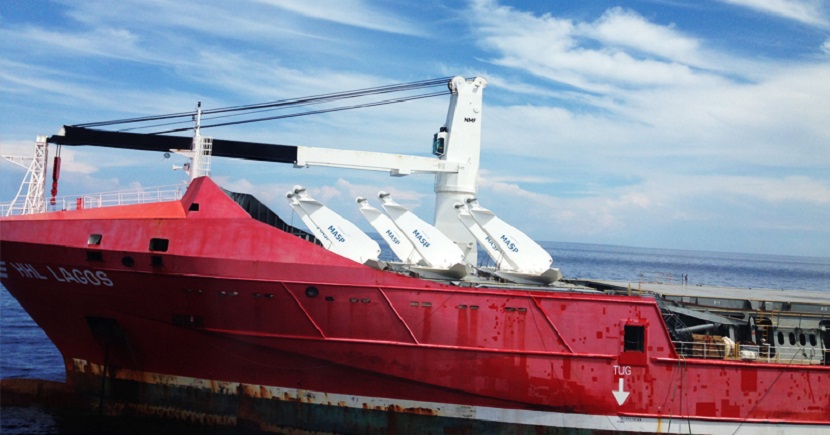First published in The Business Times on 15 January 2020.
Hit by double blows from global economic uncertainty and an industry slump, most companies might turn activity down a notch, but not Mooreast Asia.
In the past year, the mooring systems fabrication and supply business has seen key developments - from setting up an engineering centre to diversifying into a new sector - in spite of the year being a "challenging" one.
Speaking to The Business Times at his Tuas office, Sim Koon Lam, founder and managing director of Mooreast, said that the uncertain business environment and languid recovery in the oil market have led companies to hold off investments into projects.
"A lot of them are applying a wait-and-see kind of attitude," he said. For Mooreast, which services the offshore and marine industries, this means the company isn't operating at full capacity as it did during peak periods before.
But it has "still managed to do quite OK", according to Mr Sim, who shared that the company's revenue averaged S$20 million in the last few years.
"We're not complaining."
On how the company is able to stay afloat, he pointed to its readiness to transform, saying: "You have to keep yourself very flexible, and you must be adaptable to change."
Also key is financial prudence, as well as confidence and willingness from staff to stick together through thick and thin, he added.
Thinking out of the box
Mr Sim should know, having gone through multiple booms and busts during his more than 20 years in the industry, with the recent one being the oil price plunge in 2014.

He started out in the industry by joining the Singapore subsidiary of Dutch offshore contractor Vrijhof Ankers Beheer in 1992, which served as a sales and marketing outpost.
But eventually, Mr Sim felt the limitations of focusing on sales and marketing. He thought the Singapore unit should level up by moving into fabrication, but Vrijhof's Dutch management did not support him.
So, he took a leap of faith and bought out the company in 2007 with S$1.3 million, most of it borrowed from family and friends.
The unit was later rebranded to Mooreast Asia and separated from its product principal in 2014, but this took place right when oil prices collapsed.
To mitigate the impact, Mooreast decided to widen its offerings and develop new revenue streams.
This included setting up a new rigging division to provide rigging and heavy-lifting equipment and services. The division would be able to serve other industries that require heavy engineering services, such as construction.
In addition, the company started offering rigging and mooring equipment leasing. The service was targeted at helping small- and medium-sized clients reduce their capital expenditures.
"Some of those customers are only exploring marginal fields, which don't take 10 or 20 years, but probably three to five years. As a result, they prefer to have lower starting capital and test out the fields," explained Jaymes Sim, who is Mooreast's senior manager of sales and marketing, and Mr Sim's nephew.
A marginal field refers to an oil field that may not generate enough income to make it worth developing.
But if the field is worth developing, the customer may then decide to extend the equipment lease or purchase the equipment from Mooreast.
Currently, the leasing business contributes the most to Mooreast's revenue. But the company is not resting on its laurels and is continuing to push the envelope.
The company set up an engineering centre within its Tuas compound in the third quarter of last year to support product innovation and the development of new capabilities, chief of which is offshore renewable energy solutions. Mooreast's background in offshore mooring means it's well-placed to design floating structures for offshore renewable energy projects. And it's keen to co-develop renewable energy solutions with partners who can bring in the technology for generating power.
The move would help it diversify from the cyclical oil sector into an area with greater market demand, the company said. For instance, the Singapore government is making a push to improve environmental sustainability.
Countries that are stepping up the shift to renewable energy, such as South Korea and Japan, also present opportunities, said the younger Mr Sim.
The company plans to set up a new office in Taiwan but did not reveal when. Meanwhile, it has established a Singapore subsidiary called Mooreast Renewables to drive marketing efforts in Asia.
So far, Mooreast has gotten involved in a number of renewable energy projects.
One is a tidal energy project that was officially launched at Sentosa Boardwalk last September, following collaboration between Mooreast, Singapore marine renewable energy company MAKO Energy, and other local firms.
The site contributes electricity for the lighting along the boardwalk.
Also, Mooreast is currently working with universities and companies in Japan - some of which came through Enterprise Singapore's (ESG) introductions - to develop a floating axis wind turbine. The company wants to commercialise the technology once it is "fully developed".
Mooreast, where time spent on R&D comes up to two to three days a week on average, is also looking at developing an offshore floating solar panel system that's suited to open seas.
Existing systems in the market are typically deployed at reservoirs or lakes, where waters are calm. Those that have been set in seas tend to be located near the coast, where currents and waves are weaker than those in open seas. To quicken the development process, Mooreast has tapped the Technology Centre for Offshore & Marine - a connection facilitated by ESG - to help it test the performance of its floating systems using a deepwater ocean basin.
The ocean basin facility is equipped with state-of-the-art wave and current generation systems that can simulate harsh ocean environments, including those in ultra-deep waters.
"Once we see that the test result is positive, I think we can launch that (the systems) into a lot of open seas," the older Mr Sim said.
To be sure, there are also challenges, such as Mooreast's current lack of expertise in renewable energy and lack of track record, which he said is the company's biggest challenge at the moment.
"It's actually our first time getting involved with that kind of turbine (with MAKO), but we were willing to try and err. To design and build it, we went through months," he said.
Hence, the honcho appreciates the importance of partners, not only for their expertise, but also their credibility.
"Local partners can help us to build confidence in a lot of operators."
Wading into foreign waters
Mooreast is also no idler when it comes to diversifying its business markets. The nature of the industry it operates in provides a natural push for overseas expansion.
"Singapore actually has a good ecosystem for installation, so a lot of the mobilisation comes through Singapore. The OSVs (offshore support vessels) and suppliers park their vessels around here," said the younger Mr Sim.
However, not as many procurement offices are based in the Republic, he explained.
In 2014, the company set up an outfit in Europe to pursue more opportunities there. The intention was also to be closer to the industry's top providers and standards regulators, who are based there.
In addition, Mooreast has established local agents in parts of Asia, the Middle East and Brazil to promote its products and services. Asia and the Middle East are the company's biggest markets.
Looking ahead, it aims to venture into West Africa, which appears to be emerging as the next frontier for oil and gas firms.

"I think activities are picking up in West Africa, and they have quite a number of oil fields that they're willing to develop," said Mooreast's founder Mr Sim.
To further boost its internationalisation efforts, the company joined the second run of Scale-up SG last December. Launched by ESG, the programme aims to help local companies with high-growth potential scale rapidly.
It comprises three phases over 2½ years, during which the companies will work with partners such as McKinsey & Company and PwC Singapore and learn from one another to strategise and execute business acceleration plans. The older Mr Sim also credited ESG for sharing its knowledge of local markets, saying the agency "has local offices everywhere, which makes it easier for us to adapt and understand the local markets".
For example, ESG connected Mooreast to stakeholders involved in offshore wind in Taiwan, such as developers and government agencies.
It was also through a business mission led by ESG that Mooreast could learn more about the opportunities there.
All hands on deck
It is with these growth plans that Mooreast has given employees confidence to cast their lot with the company, shared its founder, when asked how it convinces staff to stay.
The company now employs 65 people, versus just 10 in 2007.
"The way to show them is in spite of the market condition, we are still growing," Mr Sim said. "Of course, it's not that kind of scale, it's slow, but we are still growing."
Mooreast is also aware of the need to take the professional development of its staff, who are largely in their 30s and 40s, seriously.
This is especially as the company operates in a niche industry, for which there's a lack of technical courses, said the younger Mr Sim.
"For general areas like safety standards... these can be covered by courses, but not what mooring consists of, and how to develop a better product."
To that end, it refined job scopes and employee evaluations last year, after a mentorship scheme found that they were too generic. The company had signed up for the SkillsFuture SME Mentors Programme where a mentor was assigned to help identify gaps in staff training and development over nine months. ESG helps to assign suitable mentors and funds the companies' participation.
With more specific job scopes and evaluations, employees now have a clearer understanding of areas to improve on.
Training is also more targeted, and improvements better measured, said the younger Mr Sim.
In all, it's perhaps no wonder the older Mr Sim was sanguine when asked for the company's outlook this year.
"I think the market will remain challenging, but I also think there will be a sign of improvement," he predicted.
"If the market turns out to be better, I'm quite sure we'll be able to do even better... we're ready and skilled to do that."


